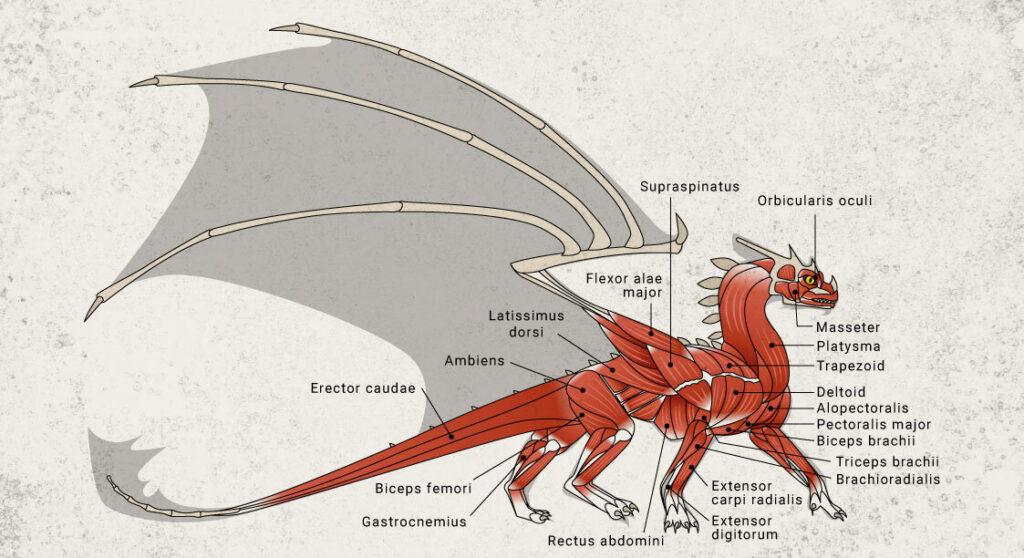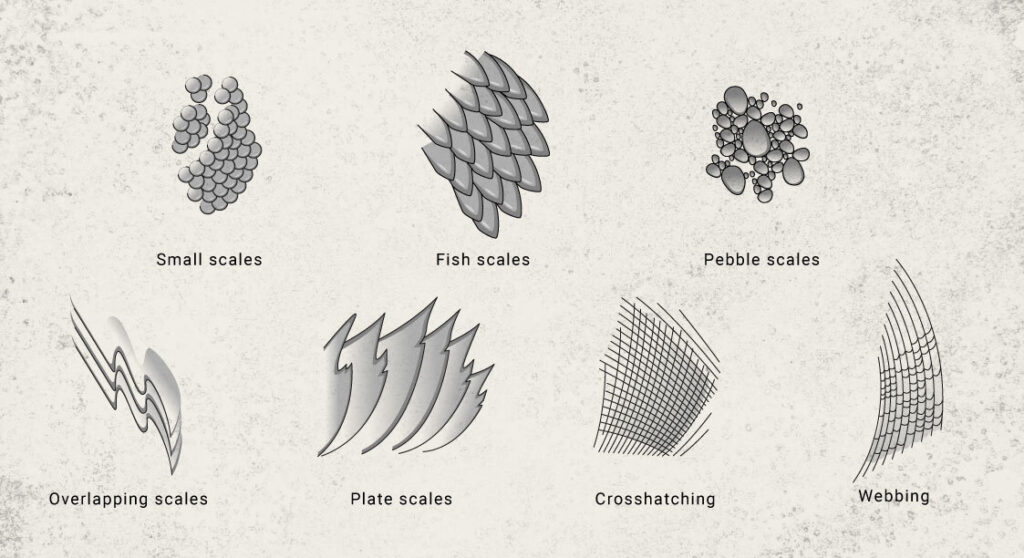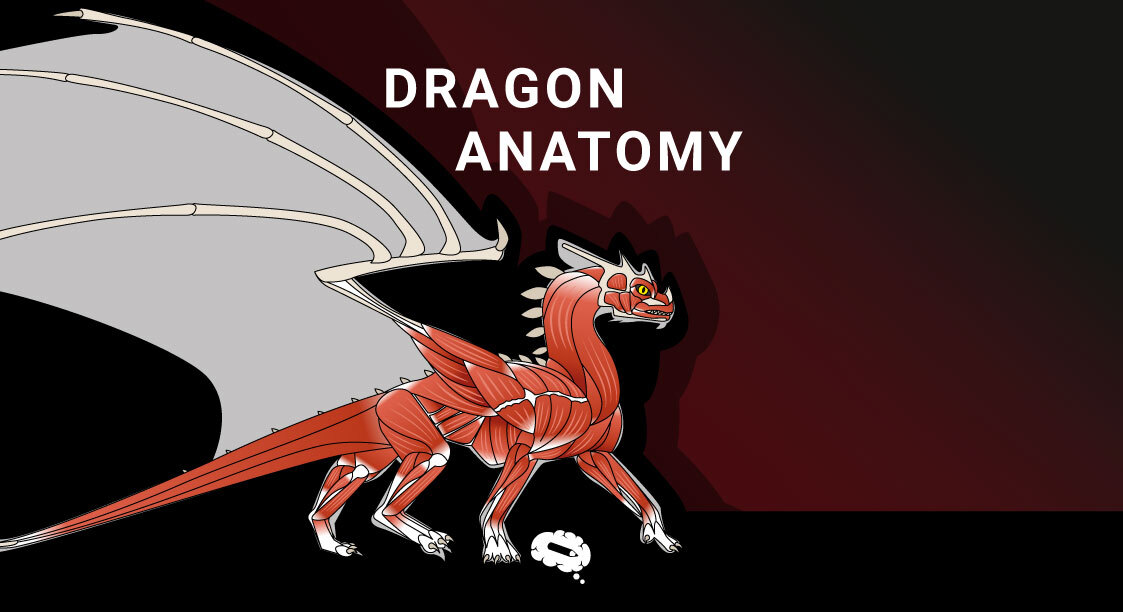Dragon, a mythological, folkloric, and folktale monster seen as harmful in some cultures and friendly in others. In medieval Europe, dragons were usually depicted as having wings, a jagged tail, and spewing fire.
Is this, however, all there is to a dragon? A serpent-like or lizard-like creature that spits fire? Mind The Graph conducted extensive research on dragon anatomy and brought you the most intriguing details.
What Is The General Anatomy Of A Dragon?
A dragon’s skeleton consists of a big head, a lengthy neck, broad shoulders, strong legs, a formidable tail, and very wide wings. The bones are incredibly strong, solid, and light, allowing them to fly. The body is covered in scales and their eyes have slit pupils.
Because the dragon bone is strong, it can endure the most severe shocks, such as falling rocks or collapsing into a sea stack. They can withstand a beating. However, dragon skeletons differ between species.
Western dragons, for example, have larger, more powerful muscles. Their masseter muscle is located in the mouth and may readily crush bones. Supraspinatus and Flexor alae major are two huge muscles located at the chest region (known as flight muscles). Western dragons have large, leathery wings that resemble those of bats.
Eastern dragons, on the other hand, have a medium-sized head, short legs, and a lengthy torso. The skeleton is particularly agile because of its serpent-like body, twisting and rotating.

What Is Dragon Anatomy Based On?
Now that you have a general understanding of dragon anatomy, it is time to go into the intricacies to discover what it is based on.
Scales
A dragon’s scales are unlike any other scaled creature; they serve not only as protection from nature’s forces and physical attacks but also to seem fearsome and/or to attract females.
There seem to be two sorts of scales: ordinary scales, the tiny scales that line the dragon’s whole body excluding the eyes, mouths, as well as other regions and scutes, larger scales that are like our fingerprints, the scutes are distinguished scales that are unique to only that dragon. Dragon scales are exceptionally heat resistant, yet they are not fully fireproof.

Eyes
Dragon eyes resemble those of other reptile species. Dragon eyes are normally slit, however as they grow gentle, the slit becomes rounder or oval. They fluctuate according to their feelings and sensations. The most usually associated with dragons is a brilliant yellow eye with a serpent-like slit for a pupil. However, dragon eyes differ depending on the species. Some might have pupil-less eyes, whereas others have bright purple eyes with larger pupils.
Wings
Obviously, the principal purpose of the dragon’s wings is flight. Nevertheless, they also serve a range of other functions, including as battle, protection, and as forelimbs for some dragons to crawl (walk).
One of the most fascinating qualities of their wings is their capacity to repair themselves. Unlike our skin, which heals by growing over and scabbing, dragon wings are said to expand out from the leading edge of the wing and finally die and fall off when it reaches the edge.
Senses
Dragons have senses similar to humans, such as sight, hearing, touch, taste, and smell, although they are far more acute. Some dragons have a sixth sense that allows them to “read” the emotions of other creatures. Most Western dragons have complete color vision, while nocturnal species have better night vision because they have more rod cells.
Fire Breath
One of the dragon’s most enduring legendary weapons is its ability to breathe fire. The belief is that dragons have hydrogen glands, which aid in flight. These glands are thought to produce fuel for fire-breathing, which, when combined with powdered platinum ingested from sediment rock, creates the fire as a reaction.
Another theory is how dragons digest their food. Food is broken down into molecules such as methane, which is stored in a kind of lung known as a hydrocarbon storage vesicle. Methane will then be combined with a small quantity of phosphor, which has the ability to ignite in flames when it comes into contact with air.
Is It Possible To Build A Dragon?
The best place to start, according to Paul Knoepfler and Julie Knoepfler, authors of How to Build a Dragon or Die Trying: A Satirical Look at Cutting-Edge Science, is with a living animal whose biology can be turned into a dragon-like creature.
The book is supposed to show that it could be possible to create a dragon starting from similar creatures utilizing science resources. The Draco lizard is one of the species described in the book, as they find it similar to a dragon, and they hypothesize that they could use genetic or stem cell methods to make the draco lizard bigger, almost as a dragon. They also highlight how cows’ digestive tracts contain a rumen, which creates massive volumes of methane.
However, the book is not a how-to guide for building a dragon, its main goal is to pique the readers’ interest, especially those who enjoy outside-the-box science.
Looking For A Detailed And Engaging Anatomy Illustration?
Building a dragon’s anatomy may be impossible, but building impressive infographics and illustrations to demonstrate anatomical systems is absolutely possible and much easier using the Mind The Graph tool. Visit our website to see the wide range of templates you can use to improve the visual perception of your work!

Subscribe to our newsletter
Exclusive high quality content about effective visual
communication in science.





